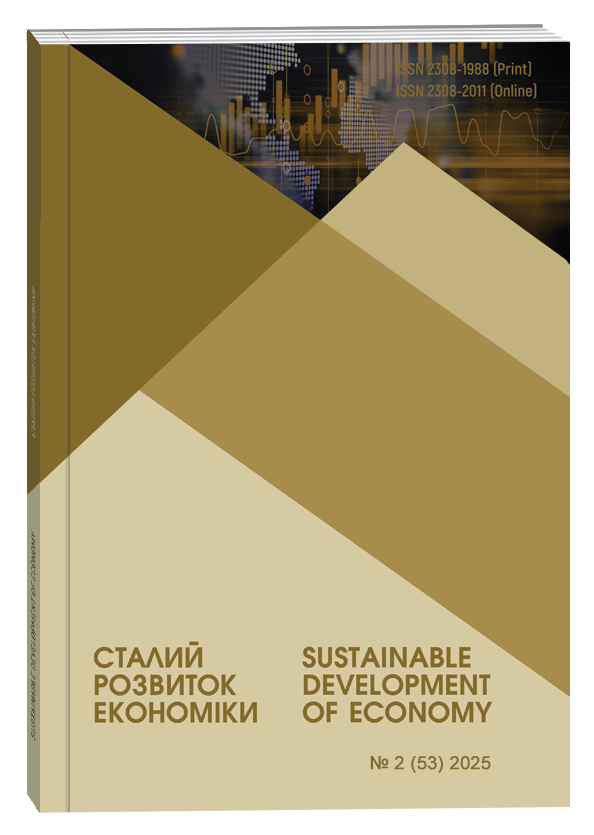ЕКОНОМІЧНА ЕФЕКТИВНІСТЬ ЗАСТОСУВАННЯ КРИПТОВАЛЮТ У БАНКІВСЬКОМУ СЕКТОРІ: АНАЛІЗ СВІТОВОГО ДОСВІДУ
Анотація
Стрімкий розвиток фінансового сектору спричинив активну інтеграцію криптовалют у банківські операції. У цьому дослідженні розглядається потенціал криптовалют як альтернативи традиційним банківським системам, з акцентом на зниження витрат, прискорення транзакцій, підвищення рівня безпеки та розширення фінансової інклюзії. Водночас використання цифрових активів супроводжується низкою викликів, зокрема високою волатильністю, регуляторною фрагментацією, кібербезпековими загрозами та проблемами масштабованості. У статті аналізується роль блокчейн-технологій у підвищенні прозорості та безпеки фінансових операцій, а також окреслюються ключові ризики, пов’язані з шахрайством, дотриманням регуляторних вимог і забезпеченням фінансової стабільності. Окрема увага приділена впливу стейблкоїнів і цифрових валют центральних банків (CBDC) на банківський сектор. Досліджуються їхні можливості для поєднання технологічних інновацій із традиційними монетарними механізмами. У статті представлено порівняльний аналіз традиційних банківських систем, криптовалютного банкінгу та CBDC за такими критеріями, як швидкість транзакцій, рівень витрат і регуляторний контроль. Результати дослідження свідчать, що криптовалютний банкінг забезпечує значні переваги у швидкості та вартості фінансових операцій, однак стикається з проблемами ліквідності та правової невизначеності. Натомість CBDC пропонують компроміс між ефективністю цифрових активів і стабільністю, гарантованою державними фінансовими інститутами. Зроблено висновок, що ефективне впровадження криптовалют у банківську систему потребує гармонізації нормативно-правових підходів, покращення масштабованості блокчейн-мереж і посилення заходів кібербезпеки. Політикам і фінансовим регуляторам необхідно знайти баланс між фінансовою стабільністю та стимулюванням інновацій у сфері цифрових фінансів. Подальші дослідження мають зосередитися на довгострокових наслідках криптовалютизації банківського сектору, впливі цифрових активів на монетарну політику та забезпеченні глобальної фінансової стабільності.
Посилання
A deep dive into blockchain scalability. (July, 2020). Crypto. Available at: https://crypto.com/en/university/blockchain-scalability
Auer R., Frost J., Gambacorta L., Monnet C., Rice T., & Shin H. S. (2022). Central bank digital currencies: Motives, economic implications, and the research frontier. Annual Review of Economics, vol. 14(1), pp. 697–721. DOI: https://doi.org/10.1146/annurev-economics-051420-020324
Boiardi P., Stout E. (2021). To what extent can blockchain help development co-operation actors meet the 2030 agenda? OECD Development Co-operation Working Papers. Available at: https://www.oecd.org/content/dam/oecd/en/publications/reports/2021/05/to-what-extent-can-blockchain-help-development-co-operation-actors-meet-the-2030-agenda_14630965/11857cb5-en.pdf
Blockchain for payment processing: Best key to a frictionless payment experience. (2024). Calibraint. Available at: https://www.calibraint.com/blog/blockchain-for-payment-processing-cross-border
Carpentier-Desjardins C., Paquet-Clouston M., Kitzler S., & Haslhofer B. (2025). Mapping the DeFi crime landscape: An evidence-based picture. Journal of Cybersecurity, no. 11(1). DOI: https://doi.org/10.1093/cybsec/tyae029
Central bank digital currencies for cross-border payments (Report to the G20). (2021). Bank for International Settlement. Available at: https://www.bis.org/publ/othp38.pdf
Chainalysis Team. (2024). The 2024 Global Adoption Index: Central & Southern Asia and Oceania (CSAO) Region Leads the World in Terms of Global Cryptocurrency Adoption. Chainalysis Blog. Available at: https://www.chainalysis.com/blog/2024-global-crypto-adoption-index/
Chainalysis Team. (2025). 2025 crypto crime trends: Illicit volumes portend record year as on-chain crime becomes increasingly diverse and professionalized. Chainalysis Blog. Available at: https://www.chainalysis.com/blog/2025-crypto-crime-report-introduction/
Cryptocurrencies and blockchain. (2018). The World Bank. Available at: https://documents1.worldbank.org/curated/en/293821525702130886/pdf/Cryptocurrencies-and-blockchain.pdf
Fox, J. (2024, December). Smart contract security risks: Today's 10 top vulnerabilities. Cobalt: Offensive Security Services. Available at: https://www.cobalt.io/blog/smart-contract-security-risks
High-level recommendations for the regulation, supervision and oversight of crypto-asset activities and markets (Final report). (2023). Financial Stability Board. Available at: https://www.fsb.org/uploads/P170723-2.pdf
King S., & Nadal S. (2012). PPCoin: Peer-to-peer crypto-currency with proof-of-stake. Computer Science. Available at: https://decred.org/research/king2012.pdf
Lannquist, A. (2023). Central bank digital currency's role in promoting financial inclusion. Fintech Notes, vol. 2023(11), pp. 1–37. DOI: https://doi.org/10.5089/9798400253331.063
Lee B. E., Moroz D. J., & Parkes D. C. (2020). The political economy of blockchain governance. SSRN Electronic Journal. DOI: https://doi.org/10.2139/ssrn.3537314
Makurin, A. A. (2019). Vyznachennia pravovoho statusu v Ukraini ta za kordonom suchasnykh hroshovykh znakiv [Determination of the legal status of modern banknotes in Ukraine and abroad]. Problemy Ekonomiky – The Problems of Economy, vol. 41(3), pp. 202–207. DOI: https://doi.org/10.32983/2222-0712-2019-3-202-207 (in Ukrainian)
Monetary Authority of Singapore. (2023). Project Cedar Phase II x Ubin+: Improving wholesale cross-border multi-currency payments and settlements. New York Federal Reserve Report. Available at: https://www.newyorkfed.org/medialibrary/media/nyic/project-cedar-phase-two-ubin-report.pdf
Nakamoto, S. (2018). Bitcoin: A peer-to-peer electronic cash system. In Bitcoin Glossary: 2018 Annual National Seminar. US Sentencing Commission. Available at: https://www.ussc.gov/sites/default/files/pdf/training/annual-national-training-seminar/2018/Emerging_Tech_Bitcoin_Crypto.pdf
Ohanian L., Orak M., & Shen S. (2023). Revisiting capital-skill complementarity, inequality, and labor share. International Finance Discussion Paper, vol. 51, pp. 479–505. DOI: https://doi.org/10.17016/ifdp.2021.1319
Oladejo M. T., & Jack L. (2020). Fraud prevention and detection in a blockchain technology environment: Challenges posed to forensic accountants. International Journal of Economics and Accounting, vol. 9, no. 4, pp. 315–335. DOI: https://doi.org/10.1504/IJEA.2020.110162
Schär F. (2021). Decentralized finance: On blockchain- and smart contract-based financial markets. Federal Reserve Bank of St. Louis Review, vol. 103(2), pp. 153–174. DOI: https://doi.org/10.20955/r.103.153-74
Shifflett, S. (2021, October 21). Crypto miners struggle to cut carbon emissions. The Wall Street Journal. Available at: https://www.wsj.com/articles/crypto-miners-struggle-to-cut-carbon-emissions-11634808781?mod=djemalertNEWS
Swiss National Bank. (2023). 116th Annual Report. Available at: https://www.snb.ch/public/publication/en/www-snb-ch/publications/communication/annual-report/annrep_2023_komplett/0_en/annrep_2023_komplett.en.pdf
Exploring CBDCs: The Next Evolution in Digital Currency. (2024, June). Kaleido: Enterprise-Grade Blockchain & Digital Asset Platform. Available at: https://www.kaleido.io/blockchain-blog/what-are-cbdcs
Terenyak L., & Kizilov A. (2024). Osoblyvosti vykorystannia tekhnolohii blokchein u sferi upravlinnia intelektualnoiu vlasnistiu [Peculiarities of using blockchain technology in the field of intellectual property management]. Visnyk Khmelnytskoho natsionalnoho universytetu. Seriia: Ekonomichni nauky – Herald of Khmelnytskyi National University. Economic Sciences, vol. 328, no. 2, pp. 70–75. DOI: https://doi.org/10.31891/2307-5740-2024-328-10 (in Ukrainian)
Youngju Y. (2020). The influence of blockchain technology on fraud and fake protection. OUR Journal: ODU Undergraduate Research Journal. Available at: https://digitalcommons.odu.edu/cgi/viewcontent.cgi?article=1086&context=ourj
A deep dive into blockchain scalability. crypto. URL: https://crypto.com/en/university/blockchain-scalability
Central bank digital currencies: motives, economic implications, and the research frontier / R. Auer et al. Annual review of economics. 2022. Vol. 14, no. 1. P. 697–721. DOI: https://doi.org/10.1146/annurev-economics-051420-020324
Boiardi P., Stout E. To what extent can blockchain help development co-operation actors meet the 2030 agenda?. Paris : OECD Development Co-operation Working Papers, 2021. 50 p. URL: https://www.oecd.org/content/dam/oecd/en/publications/reports/2021/05/to-what-extent-can-blockchain-help-development-co-operation-actors-meet-the-2030-agenda_14630965/11857cb5-en.pdf
Blockchain for payment processing: best key to a frictionless payment experience. Calibraint. URL: https://www.calibraint.com/blog/blockchain-for-payment-processing-cross-border
Mapping the DeFi crime landscape: an evidence-based picture / C. Carpentier-Desjardins et al. Journal of cybersecurity. 2025. Vol. 11, no. 1. DOI: https://doi.org/10.1093/cybsec/tyae029
Central bank digital currencies for cross-border payments. Bank for International Settlement, 2021. 37 p. URL: https://www.bis.org/publ/othp38.pdf.
The 2024 global adoption index: central & southern asia and oceania (CSAO) region leads the world in terms of global cryptocurrency adoption. Chainalysis Team, 2024. URL: https://www.chainalysis.com/blog/2024-global-crypto-adoption-index/
2025 crypto crime trends: illicit volumes portend record year as on-chain crime becomes increasingly diverse and professionalized. Chainalysis Team, 2025. URL: https://www.chainalysis.com/blog/2025-crypto-crime-report-introduction/
Cryptocurrencies and blockchain. Washington : The World Bank, 2018. 144 p. URL: https://documents1.worldbank.org/curated/en/293821525702130886/pdf/Cryptocurrencies-and-blockchain.pdf
Fox J. Smart contract security risks: today's 10 top vulnerabilities | cobalt. Cobalt: Offensive Security Services. URL: https://www.cobalt.io/blog/smart-contract-security-risks
High-level recommendations for the regulation, supervision and oversight of crypto-asset activities and markets. Financial Stability Board., 2023. 18 p. URL: https://www.fsb.org/uploads/P170723-2.pdf
King S., Nadal S. PPCoin: Peer-to-Peer Crypto-Currency with Proof-of-Stake. Computer science. 2012. URL: https://decred.org/research/king2012.pdf.
Lannquist A. Central bank digital currency's role in promoting financial inclusion. Fintech notes. 2023. Vol. 2023, no. 011. P. 1–37. DOI: https://doi.org/10.5089/9798400253331.063
Lee B. E., Moroz D. J., Parkes D. C. The political economy of blockchain governance. SSRN electronic journal. 2020. DOI: https://doi.org/10.2139/ssrn.3537314
Макурін А. Визначення правового статусу в Україні та за кордоном сучасних грошових знаків. Проблеми Економіки. 2019. Т. 41, № 3. С. 202–207. DOI: https://doi.org/10.32983/2222-0712-2019-3-202-207
Project cedar phase II x ubin+. Monetary Authority of Singapore, 2023. 51 p. URL: https://www.newyorkfed.org/medialibrary/media/nyic/project-cedar-phase-two-ubin-report.pdf
Nakamoto S. Bitcoin: a peer-to-peer electronic cash system. Bitcoin glossary: 2018 annual national seminar. 2018. URL: https://www.ussc.gov/sites/default/files/pdf/training/annual-national-training-seminar/2018/Emerging_Tech_Bitcoin_Crypto.pdf
Ohanian L., Orak M., Shen S. Revisiting capital-skill complementarity, inequality, and labor share. International finance discussion paper. 2021. Vol. 51. P. 479–505. DOI: https://doi.org/10.17016/ifdp.2021.1319
Oladejo M. T., Jack L. Fraud prevention and detection in a blockchain technology environment: challenges posed to forensic accountants. International journal of economics and accounting. 2020. Vol. 9, no. 4. P. 315–335. DOI: https://doi.org/10.1504/IJEA.2020.110162.
Schär F. Decentralized finance: on blockchain- and smart contract-based financial markets. Federal reserve bank of st. louis review. 2021. Vol. 103, no. 2. P. 153–174. DOI: https://doi.org/10.20955/r.103.153-74
Shifflett S. Crypto miners struggle to cut carbon emissions. WSJ. URL: https://www.wsj.com/articles/crypto-miners-struggle-to-cut-carbon-emissions-11634808781?mod=djemalertNEWS.
116th annual report swiss national bank 2023. Zurich : Swiss National Bank, 2023. 248 p. URL: https://www.snb.ch/public/publication/en/www-snb-ch/publications/communication/annual-report/annrep_2023_komplett/0_en/annrep_2023_komplett.en.pdf
Exploring CBDCs: The Next Evolution in Digital Currency. Kaleido: Enterprise-Grade Blockchain & Digital Asset Platform. URL: https://www.kaleido.io/blockchain-blog/what-are-cbdcs
Терняк Л., Кізілов А. Особливості використання технології блокчейн у сфері управління інтелектуальною власністю. Вісник Хмельницького національного університету. Серія: Економічні науки. 2024. Т. 328, № 2. С. 70–75. DOI: https://doi.org/10.31891/2307-5740-2024-328-10
Youngju Y. The influence of block the influence of blockchain T chain technology on F echnology on fraud and F aud and fake protection. OUR journal: ODU undergraduate research journal. 2020. No. 7. P. 1–13. URL: https://digitalcommons.odu.edu/cgi/viewcontent.cgi?article=1086&context=ourj


